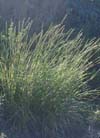
click picture for larger version
Common Name: Basin Wildrye
Other Common Name: Great Basin Wuildrye
Scientific Name: Elymus cinereus
Synonyms: Leymus cinereus
Family: Grass Family (Poaceae)
Distribution: common and widely distributed in the Intermountain West
Habitat: valley streamside, foothill and middle montane habitats
Habit: perennial bunchgrass
Height: 3-7'
Spread: 24'
Foliage Color: pale green
Leaves: grass leaves to 0.5" wide and 2' long
Flower Color: green turning straw-colored
Flower Form: flowers in a dense, elongate terminal spike
Flowering Season: mid to late summer
Cultural Requirements: Prefers full sun in rich to well-drained soils. Plants
grow more quicly in fertile soils or with added fertilizer. Fully cold-hardy. Drought
hardy (i.e., needs no supplemental water after establishment on the Wasatch
Front), but responds well to extra watering.
Culture: Readily grown from seed. Seeds are nondormant but relatively slow-
germinating. May be direct-seeded in late fall. Plants are slow-growing,
especially at first, and require at least two years to flower when spring-planted as
container stock.
Uses and Notes of Interest: This handsome, statuesque bunchgrass was
much more abundant at the time of settlement than it is now. This is the grass
that "came up to the horses' bellies" or "hid horse and rider". Meadow grazing,
haying, and urban development have eliminated most valley populations in
northern Utah. Basin wildrye was an important grain crop for native people, who
knew how to harvest it sustainably. It makes a striking specimen or back border
plant, especially when set against a wooden fence. Long-lived, the plants will
increase in size and grandeur each year. Seed is readily hand-stripped from the stalks in late summer after the heads turn straw-colored.